Software Development Exam > Software Development Videos > Android Application Development (Mobile App) > Android Application Development Tutorial - 84 - Tabs setup with TabHost
Android Application Development Tutorial - 84 - Tabs setup with TabHost Video Lecture | Android Application Development (Mobile App) - Software Development
FAQs on Android Application Development Tutorial - 84 - Tabs setup with TabHost Video Lecture - Android Application Development (Mobile App) - Software Development
| 1. What is TabHost in Android application development? |  |
Ans. TabHost is a widget in Android application development that allows the creation of a user interface with multiple tabs. Each tab can contain different activities or fragments, providing a convenient way to switch between different views within an app.
| 2. How can I set up tabs with TabHost in Android? |  |
Ans. To set up tabs with TabHost in Android, you need to follow these steps:
1. Add a TabHost widget to your layout XML file.
2. Retrieve the TabHost instance using findViewById() method in your activity.
3. Call setup() on the TabHost instance to initialize it.
4. Create TabSpec objects for each tab you want to add.
5. Set the content and label for each TabSpec using setContent() and setIndicator() methods.
6. Add the TabSpecs to the TabHost using addTab() method.
| 3. Can I customize the appearance of tabs in TabHost? |  |
Ans. Yes, you can customize the appearance of tabs in TabHost. You can use custom XML layouts for tab content and tab indicators to achieve the desired look and feel. Additionally, you can apply custom styling to the TabWidget and TabHost using styles and themes.
| 4. Is it possible to have different activities or fragments in each tab of TabHost? |  |
Ans. Yes, it is possible to have different activities or fragments in each tab of TabHost. You can create separate activities or fragments for each tab and set them as the content for the corresponding TabSpec. This allows you to provide different functionalities and user interfaces for each tab.
| 5. Are there any alternative libraries or frameworks for implementing tabs in Android applications? |  |
Ans. Yes, there are alternative libraries and frameworks available for implementing tabs in Android applications. Some popular options include ViewPager with TabLayout, BottomNavigationView, and Material Components library. These alternatives provide more flexibility and enhanced features for implementing tab-based navigation in your app.
Related Searches















